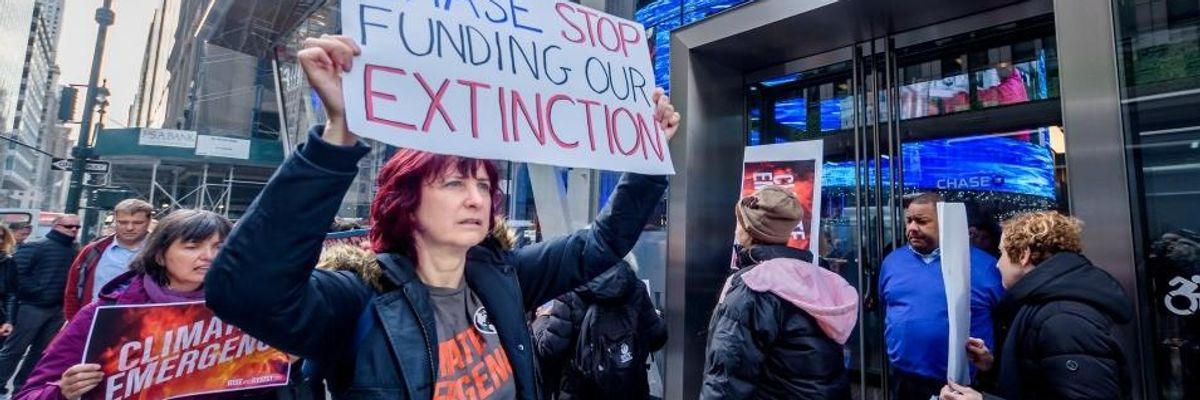The International Energy Agency (IEA) is the world's most influential energy forecaster. Providing in-depth policy advice to dozens of national governments, the IEA has long been a friend of fossil fuel executives, regularly encouraging evermore fossil fuel development, even in the face of evermore dire climate warnings. But all that started to change last week.
The IEA released a special report that represents the agency's first attempt at modeling an energy pathway that is compatible with limiting global warming to 1.5degC, the aspirational goal of the Paris Agreement.
Chase is the first major US bank to commit to 2030 climate targets; by setting the bar so devastatingly low they have made it easier for other Wall Street banks to engage in similar acts of greenwashing.Perhaps the single most important sentence in the 224-page report is this one: "There is no need for investment in new fossil fuel supply in our net zero pathway." In other words, if we want to curtail global warming to 1.5degC--and thus slow the rate of species extinction and prevent millions of early deaths--we cannot invest a single dollar more in expanding the fossil fuel industry.
Compare this with JPMorgan Chase. In October of last year, Chase, the world's largest funder of fossil fuels, announced that it was going to align its business model with the Paris Agreement. The pledge came only after years of campaigning by activists and was widely welcomed. The most exciting part of the announcement was Chase's promise to release 2030 climate targets.
Well, Chase just released those targets--and they are worse than even the most pessimistic among us feared.
Rather than actually reducing the overall greenhouse gas emissions associated with its lending, Chase has created a convoluted accounting trick known as "carbon intensity", pledging that by 2030, it will achieve a 15% reduction in the "carbon intensity" of the oil and gas firms it finances.
The most important thing to know here is that reductions in "carbon intensity" and reductions in "actual greenhouse gas emissions" are two very different things.
Imagine you are the CEO of an oil firm. Your company owns 1,000 oil wells; it doesn't own any windmills. Now Chase gives you a $10 billion loan. You use that loan to buy 400 new oil wells and 200 windmills. You now own 400 additional oil wells. This means you are digging up and burning more oil than ever before; your overall contributions to climate change have gone up significantly. But because you are now also profiting from wind power, the "carbon intensity" of your company has gone down--an accounting trick that enables your oil company to both expand oil production and meet Chase's callow climate targets.
What it boils down to is this: While the IEA states that there can be no new investment in the expansion of fossil fuels, Chase doesn't plan to reduce its investments in new fossil fuel supply at all within the next decade.
This is concerning (not to mention deeply immoral) for a number of reasons: Chase is the first major US bank to commit to 2030 climate targets; by setting the bar so devastatingly low they have made it easier for other Wall Street banks to engage in similar acts of greenwashing. Just 100 fossil fuel companies are responsible for 71% of all history's climate pollution; if Wall Street is willing to give them a pass, it is basically passing on climate action of any sort.
We need a government that is willing to step in, stop the money pipeline to climate chaos, and force Wall Street to treat global warming like the crisis it is.The fact that the media has largely fallen for Chase's big climate lie is also of concern. "JPMorgan Chase Pledges to Cut Carbon Emissions in Lending Portfolios," read one uncritical Bloomberg headline. Even the normally rigorous Guardian recently fawned about how Wall Street is acting on the climate crisis. After years of the media's failure to accurately report on the climate crisis, it is upsetting to see major media outlets fail like this.
All of this would, of course, be less alarming if the White House understood that companies like JPMorgan are a major part of the problem--and that regulating them is a major part of the solution. But that is far from the case. "No government is going to solve this problem," said US Special Climate Envoy, John Kerry in a recent interview. "The solutions are going to come from the private sector."
Kerry's words are especially alarming. Whether it's sustainable investing funds that are riddled with fossil fuels, insurance companies building coal mines, or banks making empty climate pledges, it's clear that Wall Street cannot be counted on to solve the climate crisis for us.
We need a government that is willing to step in, stop the money pipeline to climate chaos, and force Wall Street to treat global warming like the crisis it is. As the IEA has made abundantly clear that starts with ensuring that not a single dollar more goes toward expanding the fossil fuel industry.

